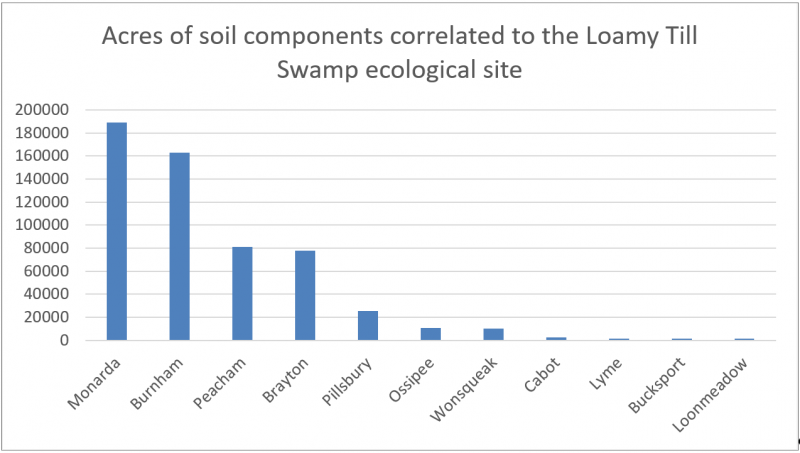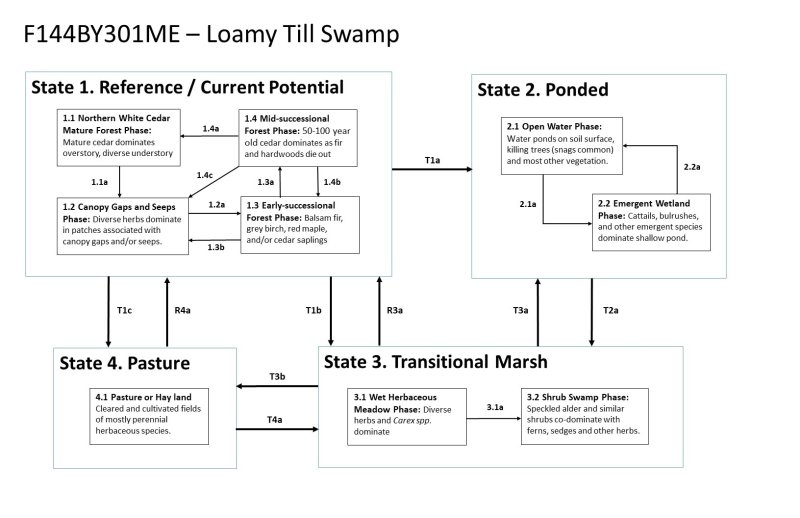
Natural Resources
Conservation Service
Ecological site F144BY301ME
Loamy Till Swamp
Last updated: 5/13/2025
Accessed: 12/22/2025
General information
Provisional. A provisional ecological site description has undergone quality control and quality assurance review. It contains a working state and transition model and enough information to identify the ecological site.
MLRA notes
Major Land Resource Area (MLRA): 144B–New England and Eastern New York Upland, Northern Part
This major land resource area (MLRA) is in Maine (56 percent), New Hampshire (22 percent), Vermont (14 percent), Massachusetts (6 percent), Connecticut (1 percent), and New York (1 percent). It makes up about 22,728 square miles (58,864 square kilometers). The MLRA consists of a relatively young landscape shaped by the Laurentide Ice Sheet, which covered the region from 35,000 to 10,000 years ago. Rolling hills of dense basal till converge on ridges of shallow bedrock that were scoured by glacial ice. River valleys that were flooded by melting glacial water or seawater house large expanses of glacial outwash and stratified drift in inland areas and, to a lesser extent, glaciomarine and glaciolacustrine sediment deposits in coastal areas. Organic bogs, ablation till, and alluvial flood plains make up the remaining portions of the MLRA.
The soils in this region are dominantly Entisols, Spodosols, and Inceptisols. They commonly have a fragipan. The dominant suborders are Ochrepts, Orthods, Aquepts, Fluvents, and Saprists. The soils in the region dominantly have a frigid soil temperature regime with some cryic areas at higher elevation, a udic soil moisture regime, and mixed mineralogy. Most of the land is forested, and 98 percent is privately owned. Significant amounts of forest products are produced including lumber, pulpwood, Christmas trees, and maple syrup. Principal agricultural crops include forage and grains for dairy cattle, potatoes, apples, and blueberries. Wildlife habitat and recreation are important land uses. Stoniness, steep slopes, and poor drainage limit the use of many of the soils.
Classification relationships
NRCS:
Land Resource Region: R—Northeastern Forage and Forest Region
MLRA: 144B—New England and Eastern New York Upland, Northern PartMLRA resources Major Land Resource Area (MLRA): 144B–New England and Eastern New York Upland, Northern Part
Ecological site concept
This site occurs on relatively flat to gentle slopes (0-8%) or on toeslopes where groundwater saturates the soil for much of the growing season and sometimes emerges at the surface. Small seepage rivulets are often evident. Soils formed in lodgment till and are poorly- to very poorly-drained. Soil textures are loamy with a mucky peat surface, and a densely compacted horizon within ~43 inches of the soil surface. The water table is usually within 12 inches of the soil surface in spring and fall, and may lower somewhat during dry summer periods. The soil surface is characterized by pit and mound topography, with ponding and thick organic matter accumulation in the pits, and drier soil conditions on the mounds where most trees are rooted.
The reference state is characterized by abundant Northern white cedar, or in southern areas by Atlantic white cedar. Further study is required to distinguish between northern and southern variants. Selective logging practices should be done when the ground is frozen to avoid churning the wet soils. Hydrologic changes due to beaver activity or man-made structure may cause year-round ponding, resulting in alternative states.
Associated sites
| F144BY305ME |
Wet Loamy Flat The Wet Loamy Flat site occurs on poorly-drained flats, which are somewhat drier and may occur upslope from the Loamy Till Swamp. Wet Flats support more spruce and less cedar. |
|---|---|
| F144BY502ME |
Loamy Till Toeslope The Loamy Till Toeslope site often occurs upslope of the Loamy Till Swamp, where soils are somewhat poorly- and poorly-drained, rather than poorly- and very poorly-drained. The Loamy Till Toeslope supports hardwood-dominant mixedwood forests rather than cedar- dominanted forests. |
| F144BY302ME |
Mucky Swamp The Mucky Peat Swamp often occurs downslope of the Loamy Till Swamp as all soils become very poorly drained and soil surface organic layer increases to greater than 16 inches. |
Similar sites
| F144BY302ME |
Mucky Swamp Both the Mucky Peat Swamp and the Loamy Till Swamp are dominated by northern white cedar, but the Mucky Peat Swamp is wetter, has a thicker organic soil surface layer, and typically has a more open canopy, allowing more light to reach the forest floor. As a result, the understory is often more productive in the Mucky Peat Swamp. |
|---|---|
| F144BY303ME |
Acidic Swamp The Acidic Swamp site has a similar complex of poorly- and very poorly-drained soils, but tends to be wetter, more acidic, and usually has coarser soil textures and weak or non-existent dense compacted layer compared to the Loamy Till Swamp site. The Acidic Swamp is dominated by black spruce rather than northern white cedar. |
Table 1. Dominant plant species
| Tree |
(1) Acer rubrum |
|---|---|
| Shrub |
Not specified |
| Herbaceous |
Not specified |
Click on box and path labels to scroll to the respective text.

